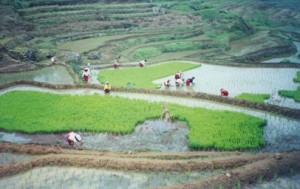By Jacob van Etten.
 Do you know the PLEC Serv List? Harold Brookfield and Helen Parsons select a peer-reviewed article on agrobiodiversity management and write a fairly long, but always interesting, summary of it, placing it in its wider context. Even though the agrobiodiversity project after which the list is called ended several years ago, Brookfield and Parsons faithfully continue it. Subscription highly recommended.
Do you know the PLEC Serv List? Harold Brookfield and Helen Parsons select a peer-reviewed article on agrobiodiversity management and write a fairly long, but always interesting, summary of it, placing it in its wider context. Even though the agrobiodiversity project after which the list is called ended several years ago, Brookfield and Parsons faithfully continue it. Subscription highly recommended.
Harold Brookfield and Edwin A. Gyasi now write in Geoforum about geographical action research. They argue it is time for geographers to get their hands and boots dirty. PLEC and the Wageningen-led Convergence of Sciences (CoS) project illustrate that research and service can and should go hand in hand. Geographers are late to recognize this, and in sister-discipline anthropology there is a far longer tradition of activism.
PLEC started by making inventories of farmers’ practices and knowledge in the areas they worked. As a result, the researchers got to know the most knowledgeable and innovative farmers. These farmers, they write, are likely to be hiding in the corners.
They cite Kojo Amanor’s poetic comment that “rather than sitting under the fig tree at the chief’s palace with dignitaries, [indigenous environmental knowledge] is best explored by taking off along the winding paths and discovering the extremities of the village, the chop bars with their bush-meat soup, the drinking spots, the jokers, the old women with their pithy comments, and the young women carrying water.”
The contacts with innovative farmers helped to set up networks in which knowledge was exchanged and new things were tried. Projects like this demonstrate how much academic scientists have to offer to the people among whom they work, and how research interests can be both broadened and deepened in so doing. There is profit in combining a measure of intervention with research.
I agree with the main thrust of the article, but I also think there are many thorns on the road. Many of the problems encountered by the Wageningen researchers lay in the institutional domain, leading to frustrated comments like “the only dependable institution in the West African rural scene is the market trader with her sense for business and entrepreneurship.”
The other problem is that working with farmers takes time, more time than normal project cycles. Only toward the end of the project did the full value of combining service with research begin to become apparent.
PLEC was discontinued. Even so, PLEC and similar projects continue to live on in other incarnations. Brookfield and Gyasi encourage others to set up similar research projects. And share their experiences.
